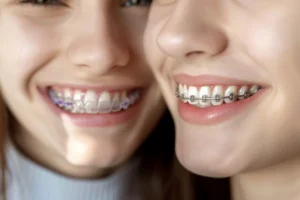Choosing between Invisalign and braces can be a pivotal decision for anyone looking to enhance their smile. Both options offer distinct advantages and suit different dental needs and lifestyles. Invisalign, known for its invisibility and convenience, is ideal for those who seek a less noticeable treatment. On the other hand, braces are typically more effective for complex dental issues and might be more cost-effective in some cases. Understanding the specifics of each treatment can help you make a well-informed decision that aligns with your dental goals and lifestyle preferences.
Invisalign: Advantages and Disadvantages
Invisalign has revolutionized the field of orthodontics by offering a clear and less obtrusive alternative to traditional braces. This modern approach utilizes a series of custom-made aligners to gradually shift teeth into their desired positions. While it offers numerous benefits, there are also some drawbacks to consider. In the following sections, we will delve into the advantages, disadvantages, and effectiveness of Invisalign to provide a comprehensive overview for those considering this treatment option.
The advent of Invisalign has provided patients with more flexibility and comfort during their orthodontic treatment. However, it’s important to understand both the positive and negative aspects of this technology before making a decision. This balanced perspective will help you make an informed choice about whether Invisalign is the right option for your dental needs.
Let’s explore Invisalign’s unique qualities, from its strengths to its limitations, and examine how effective it truly is in achieving the desired dental outcomes.
Advantages of Invisalign
One of the most notable advantages of Invisalign is its discreet appearance. Unlike traditional metal braces, Invisalign aligners are made of clear, BPA-free plastic that is virtually invisible when worn. This makes them particularly appealing to adults and teenagers who may feel self-conscious about wearing braces.
Invisalign aligners are also removable, which allows for greater flexibility in daily life. Patients can take them out when eating, brushing, and flossing, making it easier to maintain good oral hygiene compared to traditional braces, which often trap food and plaque.
- Comfort: Invisalign aligners are custom-made to fit snugly over your teeth, minimizing the discomfort often associated with braces, such as poking wires or sharp edges.
- Fewer Office Visits: With Invisalign, patients typically require fewer visits to the orthodontist. Aligners are switched every two weeks, and progress is usually checked every six to eight weeks.
Another significant benefit is the reduced treatment time. While traditional braces usually take about two years to achieve the desired results, Invisalign often completes the process in 12 to 18 months, depending on the complexity of the case.
Disadvantages of Invisalign
Despite its numerous advantages, Invisalign does come with certain drawbacks. The cost of Invisalign can be higher than traditional braces. This is because the technology and materials used in creating the custom aligners are more advanced.
Another issue is compliance. Since Invisalign aligners are removable, they rely heavily on patient discipline. Aligners need to be worn for 20-22 hours a day for optimal results, and failure to do so can extend the treatment time and potentially affect the outcome.
Invisalign is not always suitable for complex dental issues. While it is effective for a wide range of orthodontic problems, cases involving severe malocclusion, large gaps, or significant tooth movement may require traditional braces to achieve the best results.
Additionally, the maintenance of the aligners requires diligence. They need to be cleaned regularly to prevent staining and odors. Patients must also ensure they do not lose or damage their aligners, as this can interrupt the treatment process.
Effectiveness and Results
Studies have shown that Invisalign is highly effective for treating mild to moderate orthodontic issues, such as crowding, spacing, and minor bite problems. The custom-made aligners apply controlled force to teeth, moving them gradually and predictably into their proper positions.
However, the effectiveness of Invisalign largely depends on the patient’s adherence to the prescribed treatment plan. Regular follow-ups with the orthodontist and consistent wear of the aligners are crucial for achieving the desired outcomes. Invisalign aligners are designed using advanced 3D imaging technology, which allows for precise planning and monitoring of the treatment progress. This enables orthodontists to make any necessary adjustments to ensure the best possible results. In summary, Invisalign can deliver excellent results for many patients when used correctly. However, it is essential to have a thorough consultation with an experienced orthodontist to determine if this treatment is suitable for your specific dental needs. For more insights and information on orthodontic treatments, be sure to check out our other articles on related topics.
Traditional Braces: Pros and Cons
Traditional braces have been a cornerstone in orthodontic treatment for decades. Widely recognized for their ability to correct a variety of dental issues, these braces consist of metal brackets glued to the teeth and connected by wires and rubber bands. While effective, they come with their own set of advantages and disadvantages. Understanding these can help you make an informed decision about your orthodontic care.
In this article, we will explore the *pros* and *cons* of traditional braces and their effectiveness in treating complex dental cases. By providing a comprehensive overview, we aim to shed light on whether this time-tested method is the right choice for you.
Pros of Traditional Braces
One of the significant advantages of traditional braces is their effectiveness in treating a wide range of dental problems. They are often recommended for severe misalignments and complex dental issues. Traditional braces can address issues such as:
- Overcrowded teeth
- Severe overbites and underbites
- Gaps between teeth
- Jaw alignment issues
Another benefit is the durability of traditional braces. Made from high-quality stainless steel or other robust materials, they can withstand the daily pressures of chewing and talking. This makes them a reliable choice for long-term treatments that may last several months to a few years.
Cons of Traditional Braces
Despite their effectiveness, traditional braces come with some drawbacks. One notable disadvantage is the aesthetic aspect. The metal brackets and wires are quite conspicuous, which can affect the wearer’s confidence, particularly in social settings. The visibility of braces is more pronounced in adults, who might prefer less noticeable options like Invisalign.
Traditional braces can also cause discomfort and irritation. The metal components can rub against the inner cheeks and lips, leading to sores and discomfort, especially during the initial adjustment period. This can necessitate frequent visits to the orthodontist for adjustments and relief.
Maintaining oral hygiene can also be more challenging with traditional braces. Food particles can easily get stuck in the wires and brackets, increasing the risk of cavities and gum disease. It requires meticulous cleaning and regular dental check-ups to avoid oral health issues.
Effectiveness in Complex Cases
One of the most compelling reasons to choose traditional braces is their effectiveness in managing complex dental cases. Studies have shown that traditional braces are often more successful in achieving desired outcomes for severe malocclusions and significant jaw discrepancies. They provide precise control over tooth movement that is hard to replicate with other orthodontic treatments.
Orthodontists favor traditional braces for their versatility and customization. They can be adjusted to apply varying degrees of pressure on different teeth, allowing for a tailored treatment plan. This level of control is essential for treating complex issues that require multiple phases of correction.
Moreover, long-term studies have demonstrated the durability of results achieved with traditional braces. Patients who undergo this treatment often experience lasting improvements in their dental alignment and overall oral health. This makes traditional braces a viable option for those with complicated orthodontic needs.
In conclusion, traditional braces remain a robust and versatile solution for a range of dental issues, despite some drawbacks. They are particularly effective in complex cases that demand precise control and long-term results. For more insights into different orthodontic treatments and their benefits, be sure to read our other articles.
Making the Right Choice for Your Smile
Choosing the right dental treatment to enhance your smile involves careful consideration of various factors. Dental implants and their association with bone regeneration have revolutionized the field of dentistry, offering durable solutions and significantly improved aesthetics. However, understanding the different aspects such as cost, lifestyle impact, and comfort is essential to making an informed decision.
Dental implants not only restore the functionality of natural teeth but also help maintain bone structure and prevent further deterioration. This article aims to guide you through the critical aspects you need to consider before opting for dental implants. By weighing these factors, you can make a choice that best suits your needs and ensures the longevity of your smile.
Cost Considerations
One of the primary concerns for many patients considering dental implants is the cost. While implants can be more expensive than other dental procedures, their durability and effectiveness can make them a worthwhile investment in the long run. Typically, the cost can vary depending on several factors:
- The number of implants required
- The complexity of the procedure
- The need for additional treatments such as bone grafting
Patients should also consider that the upfront costs of dental implants can be offset by their long-term benefits. Unlike dentures, which may need frequent adjustments or replacements, implants are designed to last for many years with proper care. Furthermore, they help preserve jawbone integrity, potentially saving on future dental costs related to bone loss and other complications.
Lifestyle and Comfort
Another significant factor when considering dental implants is how they will fit into your lifestyle and impact your comfort. Dental implants are often praised for their natural feel and functionality, closely mimicking natural teeth. This can greatly enhance the quality of life by allowing individuals to eat, speak, and smile confidently without worrying about the slipping or clicking associated with dentures.
However, it’s also important to consider the healing process and post-operative care. The initial recovery period can involve some discomfort and dietary restrictions, but following your dentist’s instructions will help ensure a smooth and successful recovery. Long-term maintenance of dental implants is relatively straightforward, usually requiring consistent oral hygiene practices and regular dental check-ups.
Furthermore, dental implants can significantly boost self-esteem and mental well-being. Many patients report an improved sense of confidence knowing that their smile looks natural and feels comfortable. This psychological benefit should not be underestimated, as it can have a profound impact on social interactions and overall happiness.
In making the right choice for your smile, consider exploring other informative articles that delve deeper into the intricacies of dental implants, alternative treatments, and ongoing care to ensure you are fully prepared for your journey towards an improved smile.
Invisalign vs. Braces: Choose the Best Option for Your Smile
Deciding between Invisalign and traditional braces can be challenging. Below are some common questions and answers to help you understand which option might be better suited for your dental needs.
What are the main differences between Invisalign and traditional braces?
Invisalign consists of a series of custom-made, clear plastic aligners that are virtually invisible and removable. They are typically changed every two weeks to gradually move teeth into the desired position without the use of metal wires or brackets. Traditional braces, on the other hand, involve metal brackets attached to the teeth, connected by wires, and periodically tightened by a dentist or orthodontist to straighten teeth. They are not removable and are more visible than Invisalign aligners.
Which is generally more cost-effective: Invisalign or braces?
The cost of Invisalign and traditional braces can vary significantly based on the complexity of the case, the duration of treatment, and geographic location. Generally, traditional braces tend to be slightly less expensive than Invisalign. However, prices can overlap depending on specific treatment details and additional dental needs. It is best to consult with a dental professional who can provide a detailed cost comparison based on your particular case.

My name is Salman Kapa, a 73-year-old expert in bone regeneration and dental implantology. With decades of experience in the field, I am dedicated to advancing our understanding of oral health and hygiene. Through my research and writing, I aim to contribute to the development of innovative solutions in dental care.




